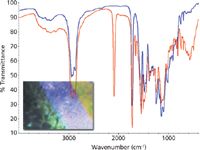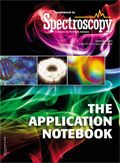Specular Reflectance Spectroscopy with Viewing
Printed ink on a coated aluminum sample was analyzed using a specular reflectance accessory with the unique capability of simultaneous sample viewing to confidently position the sample. Visual images and spectra of the sample were recorded and stored.
Printed ink on a coated aluminum sample was analyzed using a specular reflectance accessory with the unique capability of simultaneous sample viewing to confidently position the sample. Visual images and spectra of the sample were recorded and stored.
FTIR specular reflectance sampling represents an important technique useful for measurement of films on reflective substrates and bulk solid materials. The optical design of commercial specular reflection accessories requires the reflected infrared beam to be collected at an angle that is the same as the angle of incidence. In most cases, the sample is placed face down on a sampling mask or optical body of the accessory making it difficult to determine the exact sampling point. The aim of this application note is to collect an infrared spectrum of various printed colors on a coated aluminum surface using a specular reflection accessory with viewing capabilities for precise sample positioning.
Experimental Conditions
A coated aluminum sample containing multiple colors printed on the surface was analyzed using the PIKE Technologies' GladiATR Vision configured with a specular reflection viewing plate (45 degree angle of incidence). The viewing camera is situated underneath the 3 mm sampling area of the specular reflection plate. The camera magnification is 110X and the viewing area is 770 × 590 μm. The sample is illuminated using LED lights through fibers. Data collection range was 4000–400 cm-1 at a spectral resolution of 4 cm-1. Background and sample collection time was 30 s.
Results
The GladiATR Vision is a novel sampling tool which couples small area infrared analysis with simultaneous viewing. It may be fitted with a diamond or germanium ATR crystal or specular reflection plate. With an optical configuration similar to a beam condenser, the GladiATR efficiently demagnifies the beam by more than 3X for small spot-size focusing, about 3 mm, allowing collection of high quality spectra. Its all-reflective optical design enables sampling across the full near-IR, mid-IR and far-IR spectral range.
This application required various colors on a printed aluminum panel to be analyzed. Due to the close proximity of the colors on the sample, the GladiATR Vision as a sampling accessory was advantageous over traditional specular reflectance accessories because it allowed the desired sample area to be pinpointed and documented using a camera focused onto the sample. Figure 1 shows the spectra of green printed ink and an unprinted area. From the difference between these two spectra, the unique features of the green printed ink may be observed in the CN stretch region, specifically the strong absorbance band located at 2100 cm-1. The inset shows a typical image that was viewed as the sampling position was located.

Figure 1: Spectra of green printed ink (red) and an unprinted area (blue) of a coated aluminum panel; inset is a typical image from the GladiATR Vision.
Conclusions
The GladiATR Vision offers the unique capability of sample viewing coupled with measuring in either specular reflectance or ATR mode.
PIKE Technologies
6125 Cottonwood Drive, Madison, WI 53719
tel. (608) 274-2721, fax (608) 274-0103
Website: www.piketech.com
